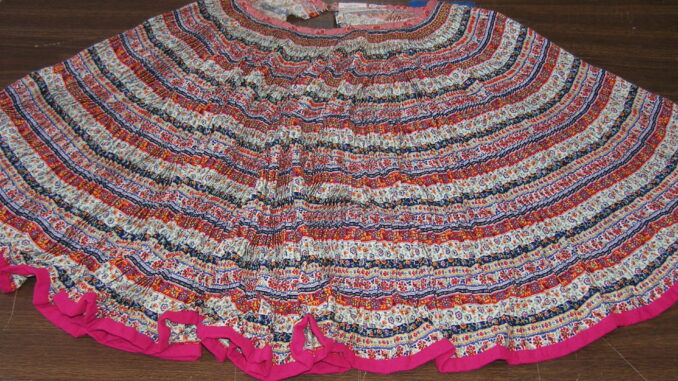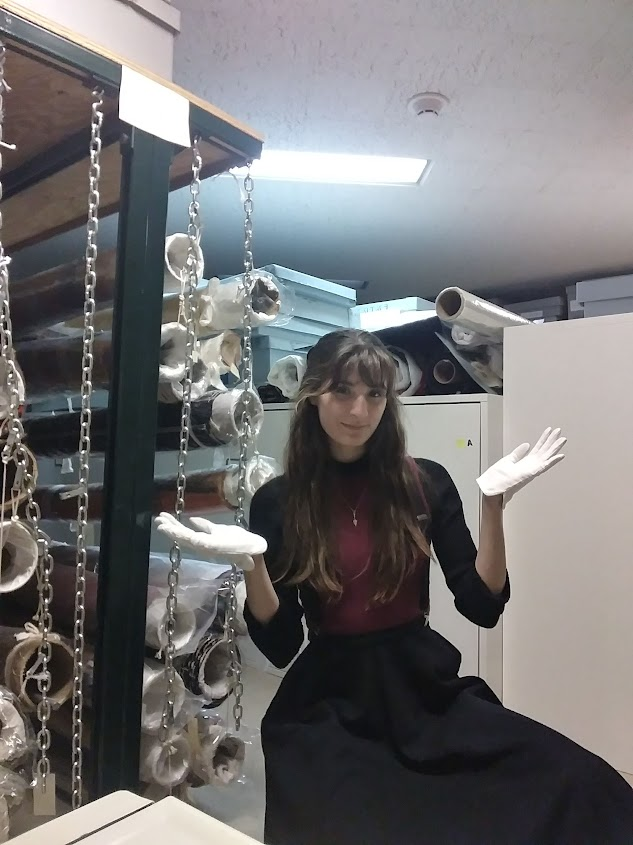
By Jillian Schwab, McClure Textile Fellow

My name is Jillian Schwab, and this is my third semester as the McClure Textile Fellow here at the Richard and Carole Cocks Art Museum (RCCAM) at Miami University. I’m an Anthropology major with minors in Archaeology, Fashion, and Museums and Society here at Miami University. I started this fellowship the fall semester of my sophomore year, and although I’m currently a junior, I will be graduating in spring 2024. This fellowship was made possible through the Jerry W. and Frances McClure Fund for Preservation of the Textile Collection, which was established in 2007.
Frances McClure, who long served the Walter Havighurst Special Collections at Miami University, and has a love for weaving and research on textiles from around the world, is the fellowship’s benefactor. Frances McClure’s late husband, Jerry McClure, was Professor Emeritus, Department of Botany at Miami University. The purpose of my fellowship has been to review the status of the textile collections and prepare a report to outline potential future documentation, rehousing, research, and conservation needs.
Starting in fall 2022, I worked under the supervision of Laura Stewart, former Collections Manager and Registrar. She introduced me to the best practices for handling textiles (clean, dry hands or cotton gloves) and taught me how to write condition reports. These reports are important for collection work, because they can provide insights into the life of the object prior to acquisition and anything that changes over time, either from storage conditions or handling effects from outgoing loans. From there, I was introduced to the main task of my fellowship: inventory and digitization.
After examining RCCAM’s textile storage area, I determined where to begin my inventory. I noticed there were a small amount of boxes that looked different from the rest, and found that they were non-archival. This is concerning for textiles because they are very sensitive to any number of conditions, including light, humidity, and acidic off-gassing from storage containers. In addition, textiles are susceptible to insects and small animals – which thankfully is not a concern at RCCAM. Regular cardboard boxes are generally acidic, and therefore are not appropriate storage for textiles. My first priority became the contents of these boxes: inventorying them, photographing them, and rehousing them to archival-standard boxes.
Unlike the usual spreadsheet, I chose to structure my inventory based on preexisting labels that were created a few years back for newly updated and inventoried boxes. That way, I could record the contents and associated information while simultaneously creating a new, updated label. This method worked well, and when the new boxes arrived this fall I was able to rehouse the textiles with the labels conveniently ready for storage. All of the textiles I encountered were photographed, and their images were uploaded to The Museum System (TMS), the online collections database that RCCAM uses. In addition to the photographs, I also entered the remaining information into the database that had not yet been digitized from the original hard copy files. In total, I worked with 23 boxes with over 200 textiles between them all.
My next stage of the inventory project lasted the entire spring 2023 semester. I moved my focus from the textile boxes to the textile cabinets. In total, there are 11 textile cabinets, A-K, ranging from 6 to 22 drawers per cabinet. With the amount of textiles stored inside the cabinets, I was very thankful for my prior inventory experience!
Despite the larger volume of textiles, I finished the cabinets in the same amount of time as the textile boxes, which was pretty cool. In all, there were over 800 textiles from around the world. One of the main donors for the textile collection, Elma Pratt, collected folk art from around the world, with significant contributions from Mexico and Central America, Northern Europe, and East Asia. Although there were few similarities stylistically, it was incredible to see the variation of weaving and embroidery techniques cross-culturally. Most of my favorite objects in the textile collection are housed in the cabinets, including a Campbell’s Soup Dress from the mid-1960s, molas from the Guna people of the San Blas Islands of Panama, a collection of embroidered blouses from Romania, and huipils worn by Yucatan Maya women. I’m beyond grateful to have worked with such a varied collection and have engaged in important preservation work to perpetually ensure the continuity of RCCAM’s textile collection.
A huge thank you to the wonderful staff and fellow interns, and all of the support I have received during my time here as the McClure Textile Fellow. Another thank you to my parents, who are steadfast supporters and encouragers of my professional interests. This fellowship, made possible through the generosity of Jerry and Frances McClure, has taught me valuable skills and created a hands-on environment with a focus on my passions, and for that I will always be honored and grateful I was chosen for this position. A very special thank you to Frances McClure herself, who has given me this opportunity to learn and grow as an aspiring textile collections professional. I will continue to work with the collection until the end of the fall 2023 semester, and then will carry these skills with me to my future endeavors: grad school and beyond.
2012.35, “Souper” Dress
Paper dress created and sold by the Campbell’s Soup Company. Design based on Andy Warhol’s Campbell’s Soup can print, ca. 1968.
Gift of Patricia Wenzel Wolf
EP2209, Cotton embroidered dress (huipil) of Yucatan-Maya costume
Cotton sack dress (huipil) for a young girl; embroidery is machine sewn. Modern, bought in Merida.
Donated by Elma Pratt
1975.T.4.10, Mola textile, Unknown Guna Artist, San Blas Islands, Panama, 20th century
Reverse applique technique; modified zoomorphic and geometric designs with crosses; predominantly red with polychrome, three to four layers of fabric
MU Alumni purchase

Jillian Schwab is a Junior at Miami University majoring in Anthropology and minoring in Archaeology, Fashion, and Museums & Society. She has interned at the RCCAM from fall 2022 to fall 2023 as the McClure Textile Fellow. She will be graduating in spring 2024.
SUPPORT US
Please visit the Art Museum Giving Page and consider a donation to support RCCAM’s exhibitions, programs, and collections.
